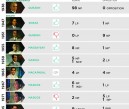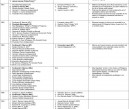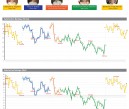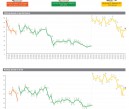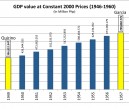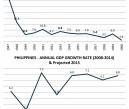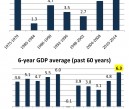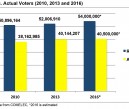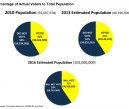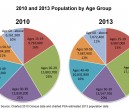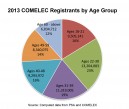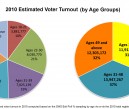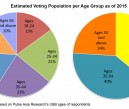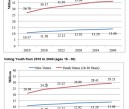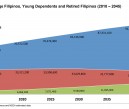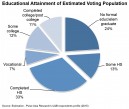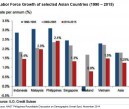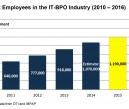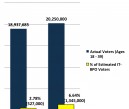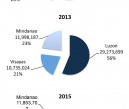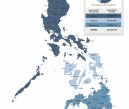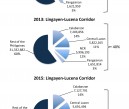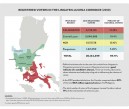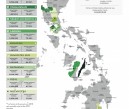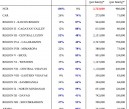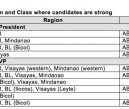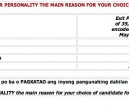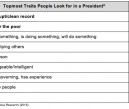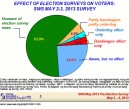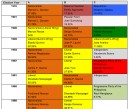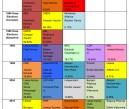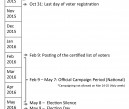The Great Referendum: The national election of 2016
An abbreviated version of this Analysis, by Undersecretary Manuel L. Quezon III, formerly an INQUIRER columnist, appears on Page A16 of the October 25, 2015 issue of the Philippine Daily Inquirer, in Talk of the Town. What follows—some 12,000 words long, with 36 highly informative tables and charts—is the full version. Please click on the images of the tables and charts to expand them or (for an even better look) to open them in a new tab.
AN AMERICAN CLERGYMAN, James Freeman Clarke, famously said, “A politician thinks of the next election. A statesman, of the next generation.” But I would add: even a statesman must be a politician, if he or she is to win an election, without which you cannot be in a position to put in place policies with the next generation in mind.
As the country prepares for what I call a Great Referendum in May, 2016, it would be useful to take a step back and look at the big picture: what is at stake, what factors will be in play, and how will we, the people, be approached to render our verdict.
Article continues after this advertisementAs always, it will be a combination of the old and the new, the familiar and unfamiliar, and of trends that have endured for generations with a generous mix of circumstances unique to this coming national election.
Since this is a continuation of my two-part series, “The Great Divide: The midterm election of 2013” (see Part 1 and Part 2), for Inquirer.net in May 2013, let me begin where I left off.
I. 2016 began in 2013
Article continues after this advertisementJust as the 2013 campaign began in 2012 (President Aquino had framed 2013 in his 2012 Sona), the 2016 campaign began in 2013, when the results of the 2013 mid-terms became known. As President Aquino summarized it in his 2013 Sona: “I asked for allies that would help steer the country in one direction, and you delivered.”
First, the results of the 2013 midterm were thus a referendum on the incumbent administration, a purpose all mid-terms have served for all administrations since the first mid-term election in 1938. (Since the restoration of bicameralism in 1941, it is the Senate, not the House, that has determined the results of the mid-term referendum, since no administration, ever, has lost the House.)
Second, only presidents and vice-presidents (elected separately, so each point to a mandate wholly their own, which meant that the Vice-President was automatically a contender for the presidency), and senators have a national constituency. Since mid-terms are a referendum on the sitting administration, a victory would boost the prospects of re-election for a president (before martial law) while a defeat would diminish the chances by turing the president into a lame duck (this is the purpose it serves post-Edsa). But as a national election, the mid-term results since 1987 also put the senatorial topnotcher in pole position to be a candidate for the presidency or the vice-presidency. (Before martial law, when senators had no term limits, the topnotcher was more likely to end up Senate President, so only in 1951, with Jose P. Laurel, who gave way to Magsaysay in 1953, and in 1963 when Gerardo Roxas ran for Vice-President with Macapagal, did mid-term topnotchers contest the presidency or vice-presidency; after EDSA, however, Gloria Macapagal-Arroyo (1995), Manuel de Castro Jr. (2001), Mar Roxas (2004), Loren Legarda (1998 and 2007), and Grace Poe (2013) all became presidential or vice-presidential candidates.)
And third, since the election had been framed as a decision between those for or against the administration, the mid-terms also marked the beginning of the realignment of parties and factions in preparation for the 2016 polls. Here, the factor of the incumbent president becomes significant.
Consider this chart in the context of the chart above.
Table. Philippine Presidential and Vice Presidential Candidates (listed in order of electoral results).
Incumbents are in bold. Candidates not belonging to a ticket are in italics. Senators or former senators have an asterisk* after their name.
You can identify a few trends. Back when presidents could run for reelection, presidents who won the midterms succeeded in seeking reelection (had Roxas and Magsaysay not died, they would probably have been reelected). Presidents who lost the midterms lost their bid for reelection. Another is that the Senate has proven to be what it was intended to be –a “training ground” for future presidents. Before martial law, only two presidents never served in the Senate: Magsaysay and Macapagal; and only House Speakers who later on joined the Senate actually succeeded. A third is that candidates with no running mate do fairly badly, and that applies to independents as well; a fourth is that the more candidates there are (particularly post-Edsa) the more susceptible preexisting coalitions become to being overtaken by other candidates.
Presidents, then, who did well in the mid-terms had excellent prospects of being re-elected before 1972, unless death intervened; post-Edsa, the mid-terms have been more important in determining if the incumbent will be a lame duck or not; with the possible exception of Corazon C. Aquino in 1992, no post-Edsa president was considered popular enough at the end of their term, to have much of an endorsement power in the election of their successor.
Presidents’ satisfaction ratings
This brings us to President Benigno S. Aquino III, who cannot seek reelection but who is uniquely positioned, as we will see, to be a formidable player in the 2016 election.
A brief word on the difference between conventional wisdom and black swans. Conventional wisdom is how past experiences, hunches, and patterns that emerge from past experiences combine to form recipes for success. But there are times when something or someone comes along to disrupt conventional thinking and behavior: Nasseem Nicholas Taleb put it forward as the “black swan theory” in 2001.
The conventional wisdom is that a president who is popular boosts, while an unpopular president can can diminish, the mid-term prospects of his or her coalition (which is, after all, competing in an election that is a referendum on the incumbent president). However, the same president, who cannot seek reelection, becomes irrelevant in the election of his or her successor. Like all conventional wisdom, there is plenty of past evidence to support this. Consider the following chart, which tracks the ratings of presidents by SWS, with elections, mid-term and presidential, marked in the same chart (both gross and net figures are represented: personally, I prefer gross numbers for surveys; gross numbers are put forward as they require media and the public to recall one number instead of digesting approve, disapprove, and no opinion numbers).
While President Corazon C. Aquino had no mid-term election per se, she was at her most popular when local and legislative elections were held in 1987, resulting in a massive sweep. By the end of her term, her popularity and thus influence was far diminished, although in the close election of 1992 it could have helped Ramos eke out a victory. Ramos with a diminished standing in 1998 could not help his candidate, De Venecia. Aquino III was at one of his highest points in the mid-terms in 2013 and at present is at the highest point of any post-Edsa president going into a national election to choose a successor.
Now let us take a look at another firm’s findings. This provides a guide to follow the ups and downs that took place in the events of 2013 to the present. We know the biggest controversies of the period: PDAF and DAP, Typhoon Yolanda, and Mamasapano.
Each of these events had the biggest effect on the President’s performance and trust ratings. Each provided a challenge to the President’s effectivity and credibility, and to the disappointment of his critics he recovered from each.
But there are two other things that ought to be factored in, related to 2016. They were: the proposal in some quarters to extend the President’s term, and the reaction of Vice President Binay to the proposal.
From 2013-2014, the proposal from some quarters to extend President Aquino’s term obsessed the political class, and what is relevant here is that it served to further deepen the divide that had been made public in 2013—that the Vice-President was head of the opposition, and was bent on consolidating the anti-Aquino forces in a coalition under his leadership. After all, as the only obvious candidate, the possibility of extending President Aquino’s term was a direct challenge to Binay’s putting himself forward for the job.
The President, then, had to think long-term while temporarily giving in to his supporters clamoring for a term extension out of fear that reforms might end in 2016. This was short-term thinking (looking at the Vice-President’s ratings at the time, and not the situation as it might be down the line). It was certainly a political high-wire act, potentially as much lose-lose as it might be win-win, without making any allowances for intervening events. The President, who might afford to take a hit in popularity so long as term extension was in the air, might not recover, even if he or the public could be convinced to go along with a term extension; and even if it was attempted, failure would leave him the lamest of lame ducks: a lose-lose.
But, on the other hand, by drawing fire to himself, and taking a temporary hit he could afford, term extension speculation would draw out fair-weather friends and show, beyond the shadow of a doubt, who was only pretending to be cooperating with the administration. And an eventual recovery, which would come after dropping the idea and thus reassuring people, would result in a sharpening of the battle lines, and thus, a win-win.
The end result in this battle of nerves was that the Vice-President lost his. The public knows very little of what vice presidents actually do, or even why the position exists; but they do expect vice presidents to be loyal; and when they break away, they suffer a loss in public esteem.
By his 2014 Sona President Aquino was thus prepared to frame the 2016 campaign, when he said, “It is you who will face a fork in the road; it is you who will decide if change will continue… In 2016, you will be choosing new leaders of our country. What I can tell you is this: if you wish to continue and even accelerate the transformation of society, there can only be one basis for choosing my successor: Who will, without a shred of doubt, continue the transformation we are achieving?”
Some observers took the same speech to mark a dividing line between President Aquino and the Vice President. The Vice President, of course, denied any such division; but actions speak for themselves, and by 2015, he had had enough, and decided not only to formally break with the President, but to go on the attack.
By doing so the Vice-President broke with conventional wisdom: No Vice President has ever gained from quarreling with an incumbent President, with the exception of Diosdado Macapagal, the first veep elected from a party different from a president elected in the same year (President Garcia systematically deprived his opposition veep of the traditional cabinet seat, and was niggardly with things like official cars, giving Macapagal four years to campaign against the incumbent). Every Vice President who broke off from the administration suffered a plunge in popularity as a result (think Laurel, Macapagal-Arroyo, and Guingona). Having been, essentially, the only declared candidate for president since 2013, the Vice President had ridden high in the ratings until his standing began to be eroded by revelations about his finances. His breaking with the President made things worse.
In reality, the Vice President was the victim of circumstances he had created in the mid-terms in 2013. It was a break inevitable because based on fundamental differences. A populist Vice President could never happily settle down in a Reform administration. Having broken conventional wisdom, one has to wonder if, on the other hand, he was also relying on the conventional wisdom that presidents at the end of their term inevitably end up unpopular and thus, politically enfeebled.
But as we’ve seen, this is far from being the case. But then, the President had one problem solved, only to be confronted with another.
In his 2015 Sona, his last, President Aquino put forward the frame once more, making it the dominant one of the election to come: “Who in their right mind would decide to cut the tree down on a whim, when we have only begun harvesting its fruits? …From this perspective, the next election will be a referendum for the Straight and Righteous Path. You will decide whether the transformation we are experiencing today will be permanent, or simply a brief and lucky deviation from a long history of failure.”
The President followed this up with the announcement of whom he would support for the presidency. The President putting Roxas forward as his preferred successor, however, created another dilemma: Would the Reform constituency end up divided on the question of both Roxas and whoever might be his running mate?
Enter Grace Poe and Chiz Escudero, members of the administration coalition since 2013, along with the NP and the NPC.
Relatively fresh in people’s minds from her topping the mid-term senatatorial elections, Grace Poe had became increasingly attractive to some fearful of a Binay presidency, and who considered her a popular alternative, encouraged by those allergic to the Liberals but who could no longer back Binay because he seemed not only increasingly vulnerable, but also because they dared not support Binay lest they incur the wrath of the President. Whether one likes the President or not, one thing is sure: When he takes the plunge, he’s all in –which discombobulates friends and foes alike who are used to more flexible presidents.
Poe could, of course, opt to run for the vice presidency. But even if Poe would consider a tandem, what to do about Escudero? Here his hand was weaker, in the sense that his viability, such as it was, was in terms of being Veep. Poe, on the other hand, was viable as either.
Very publicly, the President expressed a preference for keeping his coalition as intact as possible, particularly as conventional wisdom was blinding many of his own supporters to the uniqueness of the situation going into 2016: First, the Vice President had hogged the ratings because only he was seriously–and openly—seeking the presidency; second, the President had not explicitly endorsed a candidate, with the boost this would provide; third, the Liberal Party would go with the President, while neither Poe nor Escudero had a party.
The President kept the door open until it was Poe and Escudero, and not the President or Roxas, who shut it. The best that either Poe and Escudero would be able to do, in the future, in the face of a popular incumbent on whom they turned their back, is to insist that they’re the “loyal opposition”–but, still, opposition.
Here, the Nacionalistas, and the NPC, who have been in coalition with the Liberals since 2013, exhibited interesting behavior during this whole episode. Essentially, they stalled on making a decision—deciding, instead, not to decide (in parliamentary parlance, an abstention, which can be as politically meaningful as an explicit yes or no). When Escudero, who seems to be the political brain for the Poe-Escudero tandem, tried to engineer the impression that the NPC was poised to declare for Poe, party boss Eduardo Cojuangco Jr. stepped in and said all candidates should be talked to, preventing a stampede. When it was mentioned that the NPC was poised to coalesce with the NP, again to give the impression of a rising tide, Cynthia Villar sharply put an end to the rumor. Again, heading off the impression of a stampede.
Instead of enjoying a rising tide, Poe and Escudero found themselves becalmed in increasingly still waters. Eventually—not together, but symbolically apart, but not so apart as to totally belie that they are a tandem—each declared they would seek higher office, but with no party and no firm commitments as to a senatorial slate.
This allowed the President to fulfill his obligations as a politician and gentleman, without conceding anything. He would remain a force to reckon with; his party remained the administration party; his frame for the coming polls would be the dominant frame –the best Poe and Escudero being able to do is insist “me, too,” as far as general principles are concerned. But since the President framed—and Roxas took on the frame—of the election being fought on the basis of a referendum on his leadership, and a continuity in governance by the ruling coalition, “me, too” isn’t the same thing at all. Proclaiming yourself Beer na Beer is no substitute for being the original Pale Pilsen, however tasty you say you are. The President, in advertising parlance, enjoys the biggest brand recognition, remains the market leader, and a “me, too” challenge to that is the weakest form of contesting a market.
II. A unique election
We can still all remember how 2010 was fought along the lines of 1986 and 1953–as one senior Inquirer editor told me at the time, referring to then-Senator Aquino, “the last time I saw a candidacy like this wasn’t even in 1986, it was in 1953,” when Magsaysay ran for the presidency. Like 1953 and 1986, 2010 was a campaign to replace a discredited administration.
The 2016 election, to find a parallel, is unique. The closest analogies would be from before martial law: what should have been the reelection campaigns of Manuel Roxas in 1949 and Ramon Magsaysay in 1957, except both had died in office, and their successor–their vice-presidents—ran on the record of the predecessor. Both Manuel Roxas and Ramon Magsaysay would easily have been reelected had they not died in office; both Elpidio Quirino and Carlos P. Garcia were veteran leaders known for competence, running on platforms of continuity.
The same perils were present in 1949 and 1957, too: With Jose Avelino having split the party, Quirino eked out a victory so slim it allowed the partisans of Laurel to cast doubts on the results; while in the case of Garcia, Manuel Manahan put himself forward as a more authentic torch bearer of the Magsaysay legacy, resulting in Garcia being the first plurality president in our history; furthermore, Garcia, who kept together the party by placating party bigwigs by running with the unpopular Speaker Jose B. Laurel Jr. as his running mate, essentially conceded the vice presidency to an oppositionist, Diosdado Macapagal, who spent his entire term campaigning to defeat Garcia in 1961.
If the 1949 and 1957 elections were the last elections where the administration candidates ran on the record and achievements of the predecessor, the circumstances are different today because President Aquino can actually campaign for his chosen successor. Still, a further similarity is that during those times, the country was experiencing a stabilizing economy and had improving GDP figures. Put another way, the economy was such that campaigning on a platform of continuity was viable. But good economic numbers do not necessarily translate to electoral success, if a government has lost public confidence (as Quirino and Garcia would find out the next time around, in 1953 and 1961, respectively, when they lost, hounded by political controversy).
If perception is reality, then numbers, however impressive, have to be accompanied by the perception that the economy is being handled well. Historical GDP growth rates show that prior to 1949, the Philippine economy was experiencing low growth rates after the initial burst of activity when the country, basically flattened by World War II, had nowhere to go but up, meaning stratospheric rates of growth compared to the devastation of the war.
The readjustment to normality after the initial frenzy of rebuilding after the war meant there was a dip in growth, but after the economy returned to an even keel, it went on an upward trend in time for Quirino to be elected in 1949. It was also stable enough for Garcia to succeed in 1957. Before 2010, the economy also dipped due to the global economic crisis and depressed confidence, but was able to recover, buoyed as much by people regaining their optimism in expectation in a change of administrations, as the eventual outcome of that change. During President Aquino’s term, after an initial period of adjustment, when government reviewed its priorities and processes, the economy has bucked the regional trend and continued to grow.
Highest average GDP growth for the past 40 and 60 years
Which leads to a development conducive to an administration earning electoral goodwill:
According to NEDA Sec. Arsenio Balisacan, at 6.2%, we currently have the highest 5-year average GDP growth for the past 40 years. If we reach our GDP target of 6.8% in 2015, we will have the highest 6-year GDP average of 6.3% for the past 60 years.
This is of course an inconvenient truth to Marcos loyalists (the Aquino they hate matched their idol), but equally so, for candidates who cannot put forward credentials either in economics or finance.
The “demographic sweet spot” and “Daang Matuwid”
The NEDA projects that if “Daang Matuwid” continues (meaning its economic policies), the country’s GDP per capita will continue to increase. The projection was based on the 2014 GDP growth rate, assuming a GDP growth of 6.7% from 2015 onwards (See yellow bars in the Figure below). On the other hand, if “Daang Tiwali” will take place starting 2016, meaning an economy riddled by corruption, instability, and erratic growth due to changing policies, the economy will remain stagnant and we would see a very small increase in our economic growth for many decades to come (Red bars). This is also based on the 2014 GDP growth rate and the projected deceleration of 0.01 percentage points per year after the 2016 elections.
At the same time, there is a “demographic sweet spot,” which is essentially the potential benefits of a population that will have a larger percentage of its population of working age, just when other countries we compete against will start having a bigger percentage of their populations retiring and leaving the workforce. The premise of the country “Getting competitive,” as the Inquirer editorial last October 3 discussed, is, in political terms, who will be best positioned to navigate an increasingly interconnected and complicated world? Both in terms of integrity and competence, characteristics that have real-world consequences for people and nations, as Solita Collas-Monsod discussed on September 5 and September 12.
It is this question that the electorate will have to answer. Which brings up another question: just who, actually, are we, the voters?
III. We, The People as voters
The first divide is between those old enough to vote, and those too young to vote. The next divide is between those registered to vote, and those who aren’t. Let’s slice and dice the figures.
A. 75% of registered voters will vote in 2016
There were 74.98% registered voters who voted in 2010, while 77.2% of those who registered voted in 2013. Similarly, COMELEC is projecting a 75% turnout in 2016 with an estimate of 40.5 million votes out of the 54 million projected registrants.
B. The voters are roughly 41% of the population
In 2010, only 41% of the total population voted while 59% did not. Based on the population projections by the Philippine Statistics Authority (PSA), the percentage of voters in 2013 was still about 41%. Based on COMELEC and PSA estimates, the same percentage of voters out of the total population is also expected in 2016, around 40.5 million.
C. Almost equal male-to-female voter ratio
Of the 38 million who voted in 2010, though almost equal, slightly more females (50%) voted than males (47%). COMELEC was unable to record the gender of 3% of the actual votes.
D. The youth vote
This is the vote that candidates projecting themselves as being on the wings of change like to brag about. We are a young country, it’s true. And a new crop of voters is entering the scene.
1. Incoming voters: Population growth from 1996 to 1998
In terms of additional voters, it would be more relevant to look at the 1996-1998 population growth because it will be the youth voters aged 13 to 15 (born between 1996 and 1998) in the last 2013 midterm elections who would turn 18 and will be the new additions to the voting population in 2016. They are estimated to be an additional 3.2 million eligible voters by 2016.
- 1996 NSO projected population: 69,946,205
- 1998 NSO projected population: 73,130,985
- Total additional population from 1996-1998: 3,184,780
2. Increasing young population
The 2010 census and 2013 PSA estimate reveal that the country’s young people (ages 15 to 30) account for 41% to 42% of the total population.
In 2013, the young eligible voters (18 to 30) comprised 39% of the total number of registrants.
However, based on the estimated voter turnout from the 2010 SWS, the youth (ages 18-30) comprised only 31% of the total number of actual votes, while those aged 31-48 largely constitute the voter turnout (37%).
According to Pulse Asia, the largest group of potential voters are those aged 35 to 54 at 40%, while only 36% of the potential voters are aged 18 – 34.
Hence, these graphs show that the youth population (ages 18 – 30) are roughly 41% of the population, 39% of the total registered voters, and 31% of the actual voters.
Population projections also reveal that as the young population will continue to increase, the potential of youth voters is also likely to increase in the coming years. According to an AIM study, the youth voters (ages 18-30) will rise from about 21 million in 2010 to almost 30 million by 2040. In each presidential election between 2010 and 2040, there will be roughly 10 to 14 million potential new youth voters.
3. A different message
In 2013, the University of the Philippines conducted an online senatorial and party-list mock election. With the polls running for 5 days and an added extension, the voters’ turnout was only 4.82% for all UP campuses. This sends a different message that although there is a huge number of young people, youth voter turnout could be low, given that an expected socially and politically involved university such as UP had such a turnout. There is also the fact that Election Day is a holiday, making for a long weekend that will be tempting for young people to make plans to be with friends or go on vacation.
So here is a kind of irony. We are a young country, but in terms of elections, older voters are more active. It may be that one has to have worked for a while, and dealt with real-world problems, including having something to gain and lose, not just for one’s self, but family, to be motivated to take the time to vote. And here is a kind of cautionary possibility: if, however, an increasingly young population also becomes increasingly prosperous, as they get older, will they be as motivated to vote? We have had periodic boom-and-bust cycles which serve as a wakeup call for citizens to participate in elections to change the leadership which sets policies; if these boom-and-bust cycles happen less and less or disappear, would we face a situation like the developed world, where voter participation in elections is low? That would create a different set of problems, to be sure, in terms of democratic governance.
E. A nation in demographic transition: An increasing working age population
An increasing youth population becomes an increasing working population over time. In 2010, the percentage of the working population (ages 15 to 64) was 57.8 million. By 2045, it will be almost twice at 95.9 million, while the number of dependents will eventually decrease.
Economists predict that the Philippines will enter into a demographic transition by 2015 as the working age population grows at a much faster pace and the dependency ratio continues to decrease.
In 2010, there were about 61 dependents for every 100 working-age population. According to Dr. Juan Antonio A. Perez III, Executive Director of the Commission on Population, by 2040, it is projected that there will only be 50 dependents for every 100 working-age population.
The Philippines, currently, has the second youngest population in Southeast Asia.
It will be some time before the reforms in the educational system, such as K-12 and closer integration of the efforts of DepEd, CHEd, and TESDA are felt. In the meantime, even as young Filipinos in the educational system have a greater chance of being more educated and enjoying wider opportunities than their elders, the majority of potential voters, according to Pulse Asia’s socio-demographic analysis, are working and a large number of them have only completed high school.
Their choices, then, should take into consideration their current prospects as far as work is concerned, and their views on who can offer a compelling vision for the future, for themselves and their families.
Comparing with other Southeast Asian countries (Indonesia, Malaysia, Singapore, Thailand, Vietnam), the Philippines has the highest labor force growth rate.
As the working age population increases, this is the “demographic sweet spot” I mentioned earlier. This brings to the fore other issues, primarily of security: in terms of services from the government (health, education, safety) and measures meant to provide a greater chance for families and individuals to take advantage of opportunities –consider CCT, for example, and how people not only feel about it now, but feel about those who would either discontinue it, or drastically change it, putting those currently benefitting from it in a potentially precarious situation.
F. Filipinos abroad: A large portion but small participation
According to the Commission on Filipinos Overseas, there are an estimated 10,489,628 Filipinos outside the country (all over the world). However, only a small portion of overseas Filipinos registered and even fewer voted in 2010 and in 2013.
In 2010, the overseas Filipino votes totalled 153,323 and accounted for only 0.4% of the total 38,090,090 voter turnout in the Philippines, while in 2013, the overseas Filipino votes only accounted for 0.3% of the total actual votes.
But common sense suggests this is a misleading number, because it doesn’t account for those at home. They range from underage dependents (who don’t vote), voting-age family members who are young (so, like other young people, perhaps less inclined to actually vote), siblings and spouses and parents and grandparents who are inclined to vote, and who will therefore factor in the candidates’ views and track record in terms of protecting the interests of Filipinos abroad.
G. Increasing number of IT-BPO employees but probable small percentage of BPO voters
This brings a case similar to Overseas Filipinos: those working in IT and BPOs here at home, many of whom follow foreign time. The number of IT-BPO employees has been significantly increasing. From 527,000 direct employees in 2010, the number of direct employees nearly doubled to 1.07 million individuals in 2014. By 2015, the industry is expected to employ 1.19 million individuals while in 2016, the projected number of IT-BPO direct employees will be 1.3 million.
Although there is an increasing number of IT-BPO employees, it is estimated that only a small percentage of them actually vote, assuming that most IT-BPO workers fall within the ages of 18 to 39.
Based on the estimated 2010 voter turnouts from the 2010 SWS Exit Poll, there were more than 18 million actual voters aged 18 to 39. In other words, in 2010, the actual voters aged 18 to 39 actually comprised 50% of the total actual voting population. During the same year, DTI and IBPAP recorded that there were 527,000 IT-BPO direct employees. Of the 18 million (ages 18-39) who voted in 2010, only 2.78% IT-BPO employees probably voted on election day.
Assuming that there will be an increase in total voter turnouts (as per COMELEC) and that the 18-39 actual voters will also be 50% of the projected actual voting population in 2016, there will be 20 million who would actually vote from the same age group. Out of the estimated 20 million 18-39 voters, only 6.64% IT-BPO employees would probably vote in 2016.
At the same time, most employees in the IT-BPO sector work during graveyard hours and are less likely not to vote come election day. Like Filipinos abroad, chances are their parents and grandparents will be the ones to vote.
H. Religion and Voters
Aside from the Youth Vote, and appealing to Filipinos abroad and their families, candidates take pains to court the support of sectors in a position to pledge their members’ support. This includes religious groups.
1. The INC vote
In the Philippines, the Iglesia ni Cristo (INC) is open to, and has proven numbers for, undertaking command voting especially for local elections. According to Mahar Mangahas, from their SWS/TV5 Exit Poll in 2010, 4.23% of the valid votes for President were cast by people who declared their religion to be INC. This adds up to an estimated 1.53 million votes from INC in 2010. Currently, Mangahas predicts that there will be around 1.7 million votes from the INC in 2016 in terms of Presidential and Vice Presidential posts.
2. The Catholic vote
Although the Catholic Church does not endorse candidates, Catholic voters comprise most of the total voting population, with more than 80% of Filipinos being Catholics. During the peak of the RH bill issue, the question of whether there will be a Catholic vote in the 2013 elections suddenly erupted.
Mahar Mangahas indicated that in all his experience with election surveys, he has never seen a Catholic vote or any charismatic group vote; the only solid religious vote, so far, has been the Iglesia ni Cristo Vote.
Still, several Catholic bishops and movements publicly endorsed anti-RH candidates in 2013. The Diocese of Bacolod even put up a large tarpaulin bearing the names of candidates who opposed the RH bill and branded them as “Team Buhay” while those who voted for it as “Team Patay.” However, after the elections, the Catholic Church leaders were disappointed that their campaign did not have much impact on the senatorial elections.
Antonio Montalvan, on the other hand, questioned that if indeed there was no Catholic vote, why did 6 of the 12 senatorial candidates and 55 of the 100-plus congressmen who were against the RH Bill still win? But the RH bill was voted on by the Senate and the House in December 2012 (it passed by 13-8 in the Senate, and in the House by 113-104 in the crucial 2nd reading vote and 133-79 in the final reading vote: not to mention that the hierarchy itself was divided among moderates and hard-liners), giving enough time for tempers to subside by the time of the mid-term election.
Reality may lie somewhere in the middle: In tight local races, interventionist bishops can rely on committed groups of the lay faithful to use their influence on family members and thereby affect the outcome. This is why the battle over the RH Bill was toughest in the House, where congressmen worried about the impact of bishops campaigning against them.
Nationally, however, the Catholic Church can exercise what is called a “negative vote” but only moderately so; this also explains why some senators were generally unafraid to support the RH Bill, while others aligned their position on the measure with the stand of the Catholic hierarchy.
3. The Moro vote
There is an estimated 6% Muslims out of the total population, slightly larger than the INC group, which constitutes only 2% of the population. While there is no “Muslim vote,” the habit of perpetuating political dynasties to support the interests of particular national politicians has been known to persist in Mindanao.
According to the pre-election survey of SWS in April 2010, the command votes tend to be more visible in areas farther away from the capital, mostly in Mindanao (22%).
The ARMM provinces, in particular, have been known for several election controversies such as the famous “Hello Garci” scandal in 2004 and the “Lintang Bedol” case in the 2007 elections. In 2004, Arroyo had a contentious high turnout compared to that of FPJ. In fact, 17% of Arroyo’s total votes obtained in Mindanao came from ARMM. This was fostered by ARMM elections taking place outside the schedule for national elections. ARMM votes in the hands of unscrupulous local and national leaders, then, could be put up for sale to change the outcomes of national contests.
In 2011, ARMM elections were synchronized with national elections, and few noticed that for the first time in many elections, the absence of a lag or even of controversies regarding the ARMM outcome resulted in a relatively controversy-free result. The elections of 2016 will mark the first time ARMM and presidential elections are synchronized, which means Moro leaders and the Christian politicians who used them are fighting their own contests and will have little time or opportunity to revert to old habits.
They will be voting on the same day as everyone else; leaders with committed (or at least obedient) followers will have to throw in their lot with national candidates without knowing what the outcome will be. It remains to be seen if the candidates’ opinions on the passage of the Bangsamoro Basic Law will form a Moro bloc vote.
HAVING TAKEN A LOOK at demographics–some aspects of our population in terms of sex, age, education, for example—we need to look at geography and the things that allow candidates to reach the most number of people in the most efficient yet effective way possible.
IV. Where are the voters?
Before 1986, tickets were geographically balanced, on the basis of appealing to the North and the South. In 1986, however, for the first time, the contending tandems were both Luzon-centered: Marcos and Tolentino were from the Ilocos and Manila, and Aquino-Laurel were from Tarlac and Batangas, respectively. The waning of a geographically balanced ticket is a reflection of where the voters are.
A. More than half of the voting population are in Luzon
- At 56% in 2010, more than half of the registered voters came from Luzon, with 24% from Mindanao, and 20% from the Visayas. The case was similar in 2013, where 56% of registered voters were from Luzon, 23% from Mindanao, and 21% from the Visayas.
- Luzon increased by 904,809 registrants. The Visayas increased by 444,934 registrants, while Mindanao decreased by 66,566 registrants.
B. Highest number of registered voters are in the Lingayen-Lucena corridor
In both the 2010 and 2013 presidential elections, the Lingayen-Lucena Corridor comprised almost 40% of the total 50.7 million registered voters in the Philippines.
C. Provinces with the most number of voters: Cebu, Cavite, and Pangasinan
Data suggests that the highest voter turnout actually occurred in highly urbanized cities such as Metro Manila and Cebu. Apart from NCR, the number of registered voters remained highest in Cebu, Cavite, Pangasinan, and Negros Occidental both in 2010 and 2013.
In contrast with 2010, in 2013 more people from Laguna registered to vote than those from Bulacan, while there were more registered voters in Rizal than those in Nueva Ecija.
You will notice from the above that the old “Solid North” is no longer “vote-rich” the way it used to be. The map does not show, on the other hand, regions that are considered to vote as a bloc for national candidates from their region: Bicol is the most famous example. Nor do these maps take into consideration the shifts in population in the country (Ilocanos in Aurora and other provinces, for example). But on the whole, in terms of the sheer number of votes, NCR, Balance Luzon (specifically the Lingayen-Lucena Corridor), Cebu, Negros Occidental and Davao del Sur are the plum prizes in seeking votes.
D. The urban vs. rural divide
The classification of an “urban” area is based on meeting a required population density. This means that a highly urbanized province always has more people/voters. The table below shows the percentage population of urban vs. rural areas in the Philippines and the household ownership of TV and personal computers — this tells us “where the people are” and “the equipment they own”:
The majority of the population, therefore, live in rural areas and own more television sets than personal computers.
This allows us to zero in on a few things: While there are more rural residents than urban residents, turnout is higher in urban areas. Internet access is highest in urban areas, which could potentially affect turnout for candidates, but dwarfed in comparison to access to television, which can affect turnout for all candidates everywhere there’s TV.
And it tells us, most of all, why the political class speak of an “Air War” and a “Ground War,” in elections.
V. At the starting line
And so, the moment when all is revealed: Filing Day, when the candidates declare themselves as such and, without any doubt, throw their hats in the ring. Consider this projection, which is simply based on my observations at present.
Even if, as we saw earlier, voters pondering their choices in the local and national races can practice what is called “strategic voting,” there is a loophole, so to speak: ethnic votes or bailiwicks—most famously, the so-called “Solid North” and the Bicol vote.
The long road to October 2015, which began in June 2013, had as its goal obtaining, for a candidate, that other factor often described as “winnability,” the perception that popularity will attract all the other conditions–funding, machinery through a party or coalition, volunteers—necessary to mount a viable campaign.
But this calculus can be upset by the calculus of others. Since everyone is looking at the loopholes, the different candidates can cancel each other’s advantages out. They can fracture a constituency to the extent that the rival constituency can win. The strength of one candidate in ethnic terms can be cancelled out by greater strength in the same region by another. Effectivity in the “air war”–pitching for votes in media and online—can be challenged by the “ground war”–the hard, door-to-door, village-to-village slog by candidates, party members, and volunteers.
At present, you could slice and dice the “winnability” stakes –the respective strengths of candidates they can build on—as follows.
If you look at my projection, above, 2016 may turn out to be something along these lines, at least based on where I think the candidates are at the starting line.
Only two candidates can claim to dominate a crucial region: Roxas in the Visayas and Duterte in Christian Mindanao, respectively. Roxas-Robredo has a strong claim on Bicol, but this puts them in direct competition with Poe-Escudero. At present, Poe and Binay can claim an advantage in NCR, but they are in competition and cannot count the administration out in this regard; there is the additional complication of Duterte in NCR. Poe might claim an advantage in BL (Balance Luzon) but this ignores the lingering bailiwicks of the Liberals, such as Quezon Province, while Binay’s assiduous courtship of Arroyo and the Marcoses, and his settling on Honasan, showed his geographical instincts.
Vice presidential candidates also add to the geographical calculus of presidential candidates. It seems the most hotly contested region will be the Bicol region, with Escudero, Honasan Robredo, and Trillanes all putting a claim on the votes of the region. Marcos can claim the “Solid North,” and can put in a claim to the loyalty of Leyte. As senators, Cayetano and Honasan can also claim regional bailiwicks based on their previous electoral records.
What is particularly interesting is the number of candidates with nothing to lose. Poe, Trillanes, Cayetano, Escudero, Honasan can all return to the Senate, if they end up losing in 2016. They remain viable as candidates after that. The only candidates who are really taking a risk are Roxas (out of office, but who could have played safe and returned to the Senate), Bongbong Marcos (who could have sought a safe reelection to the Senate), and Leni Robredo (who could also have safely sought reelection to the House).
The continuing silence, as of this writing, of the Nacionalistas and the NPC suggests that they will concentrate on maintaining their seats in the House and their local bailiwicks, making themselves parties to court once a new administration is elected.
If either party declares, in the end, that they will not endorse any of the presidential candidates, then the net advantage will be for the administration, and the net disadvantage, to Poe, who was unable to prove either she or her running mate could attract a party enough to take a stand in her corner–unless she, or one of the other candidates, can scoop up the local party bigwigs of the NP or NPC.
But they can afford to hold out beyond election day. Granted, once a winner is proclaimed, another realignment will take place, which is why even in the past, although no administration –even the ones that lost the presidency—ever lost the House, every new administration soon enough puts together a new ruling coalition in the House, too (the Senate is equally susceptible, but slightly less so, during mid-terms). An organized party, which, regardless of the outcome of the presidential and vice-presidential polls, holds on to, or expands its bloc in the House, is a force to reckon with–and one to court for support.
But that’s another story.
VI. How we decide whom to vote for
Having seen who we are, and where we are, as voters, we now come to the two ways our votes will be courted. The “Ground War,” creates, to use a newish term, “content” both for TV (and other traditional media) and online. People take screenshots of news; they post videos of things they see around them, and what they see can go viral, and by going viral, become part of the news cycle. Unlike the news (remember the old saying that only bad news sells), something touching, or cute, has as much of a chance of going viral as something disgusting, or shocking.
The most efficient way to reach the voter also happens to be the way voters like to be reached–through television. To be sure, a growing number of people are not only also online, but look at different screens at the same time: They will watch a show on TV, and react to what they see on Twitter and FaceBook, for example.
A. More Filipinos today use the Internet and social media
As of 2014, 57% of the population uses the Internet, which is equivalent to 58,690,221 internet users in the Philippines.
According to Nielsen,
- There are 54,053,000 Filipino Facebook users;
- 11,914,115 Filipino Twitter users; and
- 7,336, 277 Filipino Tumblr users.
In another survey, results show that mobile internet users are now becoming a fast growing group of people:
- 96% of mobile internet users in the Philippines use Facebook while 54% in the US do; and
- 42% of total screen time in the Philippines is on social media. Filipino social media users are number 1 in the Asia Pacific region, spending 4 hours a day in all social channels, while Chinese only spend 1.5 hours a day and Indonesians spend 2.9 hours a day.
But even as we all explore this brave new world, the current reality is that TV is still king. There are other screens, though, that, together with TV, contribute to the “Air War,” and can become a factor in the “Ground War.” For example, if you still remember Farmville, then you’ll remember that besides the youth, among the busiest people online are senior citizens, who are more likely to vote, and who can influence others to vote. A young person unlikely to vote can still gleefully help a positive or a negative go viral, which in turn can be spotted on the net, on a phone, or on TV by someone older and more likely to vote. It’s an infinite feedback loop all the way to election day.
B. TV is the primary source of information for most Filipinos.
So although there is an increasingly large number of Internet users today, according to a survey in 2013, TV is still the primary source of information for most Filipinos. In particular, most Filipino voters still rely on TV ads as their sources of information concerning the candidates.
In 2013, a study on the youth vote by the Asian Institute of Management (AIM), which conducted a mock election, showed that a quarter of the student sample indicated that their votes were influenced by the candidates’ last name, while 28.13 percent of the student sample voted on the basis of the candidates’ television ads. Only two percent of the respondents based their vote on the platforms of the 12 senatorial candidates. In 2010, I posted the platforms of the presidential and vice-presidential candidates online. You can access them here: it’s interesting to see the readership (views) for each.
That being the case, are advertisements “epal” behavior, or a legitimate means for the public to get to know candidates in an era when the speeches in the plaza aren’t community events anymore?
My view is that if someone were to ask in a survey if the public considered advertisements as “premature campaigning,” I doubt if the results would be against ads. One reason is ingrained behavior–as I pointed out at the start, speculation and jockeying for a presidential election begins the moment the mid-term results are known; and when it comes to an electorate that has long foregone the public plaza as the place to find out about candidates (prospective or otherwise), TV is the widest, and easiest, means to get to know who is running and why.
Which brings us to that marvelous and mysterious document, the “Platform.” They have been a feature of every presidential election in the same manner that coalitions have featured in our presidential elections from the start: see the Coalition Platform for 1935.
C. Platform, personality, and parties in choosing a President
For parties and coalitions composed of parties, and individual candidates, there are two documents that serve to bind together those committed to the common cause: the coalition or party platform, and the sample ballot.
While every coalition seeking the presidency has put forward a platform since 1935, platforms per se–meaning, a specific policy document, and not just generalized notions of what the voter gets the impression the candidate is all about—while very important, don’t seem to appeal either to voters, or even media, much less the members of the coalitions concerned. (As an aside, what matters then is if the platform matters to the candidate concerned and his or her principal lieutenants tasked with turning policy into reality.)
Based on the SWS exit poll in 2010, people equally consider platform and personality as reasons for choosing a President.
It is important to note that according to poll experts, respondents in general tend to give “socially desirable” answers. For example, respondents in general will answer that they do not tolerate corruption, but when asked how many times they tried to bribe someone, results showed the opposite of the socially desirable answer.
But another thing I pointed out in 2013 suggests a simpler explanation for the above. Back then, I pointed to a 2010 survey that revealed that as far as the public is concerned, “news” as a source of information had an incredibly elastic definition: “news” could come from the evening news, but it could also come from a game show–and game shows, for example, have a gigantic audience compared to the news. So it may be, too, for what constitutes a “platform” for the public –slogans, speeches, anything and everything where a candidate’s opinions (and thus, position, on a question) might constitute a “platform.” Personality, then, in the survey above, could then refer to all the other intangibles–likeability and credibility, for example.
So if the platform-as-document itself is ignored, there is another document that is far less likely to be ignored –in fact, it could be considered an electoral lifesaver. This is the sample ballot.
The sample ballot cuts across classes, as it’s a simple crib sheet. (Case in point: Survey after survey shows that most people decide on eight names for the Senate, but there are twelve slots; a sample ballot is crucial to prevent the extra four names from being left blank.) Parties in all countries focus on getting people to go out and vote, and having their representatives make sure that ballots are counted correctly; if voters were to show up, and leave many names blank, it would be counterproductive.
But it’s the sample ballot that is of critical importance to all candidates and coalitions. The sample ballot is what connects the local to the national; it allows local leaders to hang on to the coattails of strong candidates ; it allows weaker candidates to ride on the drawing power of strong local candidates. For local candidates, it is the IOU that gives them a seat at the table of what will hopefully be the new national leadership; it is the calling card that gives national candidates access to the networks that constitute local communities.
Which brings us to political parties.
Why does a party matter, if the conventional wisdom is that parties are personal vehicles and not organized groups of like-minded people? The reality is they are both, and we are not unique in this regard. Yuko Kasuya, for example, in his book “Presidential Bandwagon: Parties and Party Systems in the Philippines” (Anvil, 2009), points out that Koreans follow leaders instead of parties.
Parties serve another purpose. They serve as venues where fights can be mediated, and disagreements refereed. It is in the party, and among parties, in the coalition, that authorities–party bigwigs—can be appealed to, to solve problems.
Consider these terms you often read about. For local and House elections, there are “Free Zones,” (where factions in a party or different parties agree not to put up an official candidate). You hear about the “Equity of the Incumbent” (where, if an official candidate is to be decided on, the incumbent holder of the office has a claim to being the official bet) and, for the Senate, the phenomenon of the “Guest Candidate, ” where two or more parties decide to have one candidate on their respective slates, which began with Claro M. Recto’s senatorial candidacy in 1955. All these are manifestations of party and coalition negotiations, and an enormous amount of time is spent by national candidates and party leaders on these matters: whose hand will you raise, with the photo to appear in posters? Whatever your decision, someone will be unhappy.
Being able to achieve net happiness instead of dissatisfaction among your supporters is the first test of leadership for a presidential candidate. Your decision can deprive a rival of an ally, or drive the disaffected into the arms of your opponents. But if the result of a free zone is a lack of a genuine contest in an area, then most voters might stay away–which would benefit those unscrupulous candidates, particularly national candidates, who want to rely on machinery, whether provided by politicians, warlords, or other “leaders.”
Historian Mina Roces in her book on kinship politics puts forward three interesting concepts: “palakasan,” and within it, the ideas of “malakas” and “mahina.” A candidate who has a party is a candidate “malakas” enough to obtain the public support of the local leaders who constitute the party network, and in turn, their followers.
A candidate unable to obtain party support immediately projects being “mahina,” in that at best, only a loose network of individuals are pledged to support that candidate which means discipline and cohesion, not to mention logistics, are that much more difficult to organize. On the other hand, a candidate projects strength when political heavyweights commit to your candidacy. For those outside an administration, it is a mutual pledge to achieving happier times; for those in the administration, particularly if the incumbent president remains popular and active (as I mentioned, a unique situation as far as the present incumbent is concerned), it is an attractive proposition: you can hope endorsement will give you a boost, and for the remaining year of the incumbent’s term, you retain a direct line to the Palace.
To be sure, there is a kind of amorality –not immorality—in “malakas” and “mahina.” Are they strong? Fierce? If they are, maybe they can help me.
There remains, however, an idealistic streak even in the most jaded Filipino; and as a society, we judge our candidates as we judge people. Are they good? Are they kind? If they are, maybe they can help me.
And this is where your approach determines which candidate has a chance of attracting your vote.
D. Not corrupt/clean record as topmost reason for choosing a President
If Mina Roces described our approach to those who have, or seek, power, then there’s another useful point of view to make sense of how different points of view compete in elections.
Back in 2010 the American scholar Dr. Mark Thompson described Philippine politics as characterized by an “emergent cleavage,” by which he meant that if you trace our political development over the past 60 years (and even earlier), there are two contending points of view in every election: those of Reformists and Populists. Reformists (Magsaysay, Ninoy and Cory, Ramos, Aquino III) appeal to voters as an inclusive community, cutting across class, ethnic, and religious lines, on the basis of sacrifice and thus “goodness,” on a pledge not to steal, and to govern in the national and not personal, interest. Populists (matinee idol Rogelio de la Rosa who briefly ran for president in 1961, Marcos, Estrada, FPJ) on the other hand, appeal to voters on the basis of highlighting class divisions (particularly resentment of the elite), on “us” versus “them,” and the idea that the candidate is like the voter and will thus help the voter. Both reformists and populists, on the other hand, put themselves forward as being against clientelism (the post Edsa Dos incarnation of Arroyo, for example)–the traditional use of force, bribery, and cronyism, to defy public opinion and manipulate electoral results.
Past survey results showed that the topmost reasons for choosing a President is if a candidate is not corrupt or has a clean record and if he or she cares for the poor. The same surveys, however, also suggest other traits can add to or detract from that consideration–or serve as an equally compelling reason to support a candidate. In other words, you can see a cleavage–between characteristics a Reformist would find attractive or relevant, and those someone who is a Populist would consider important (add a dash of “palakasan” courtesy of Mina Roces here, folks!).
The rankings above represent a snapshot of the whole. Similarly, the most frequently mentioned qualities of a good leader, based on the Institute of Philippine Culture study of the poor reported by the PCIJ in 2004, are the following:
- God-fearing
- Helpful
- Loyal
- Responsible
- Intelligent
- Hardworking
- Principled
- Keeps promises
- Trustworthy
The same April 2004 article also examined the most frequently mentioned qualities by the poor of a bad leader and were ranked as follows:
- Corrupt
- Liar
- Greedy
- Irresponsible
- Selfish
- Abusive
- Has vices
- Lazy
As the Institute of Philippine Culture found out, much as Populists might think otherwise, poor voters put a premium on positive traits, too, not very different from the community as a whole. Reformists, though, might be disappointed in that some traits they consider of paramount importance aren’t as important when considering the whole community.
E. Small influence of election surveys on voting decision
A brief note on surveys. The SWS Pre-election Survey in 2013 found that most people are unaware of election survey news and the influence of election surveys on voting decision is weak.
Earlier surveys also showed that election surveys are not likely to influence one’s vote.
But even if one accepts what the public says, there is one group for whom the surveys matter to the extent that it can alter their behavior –the politicians. Commitments may change depending on the latest political temperature of a candidate. The behavior of the candidate can change, too; some may reach the point where they will have to decide if they will double down time, energy, and resources for a faltering campaign, or cut their losses. And that, in turn, can affect the voters.
But here’s a quick tip on reading the results of surveys. Don’t forget the margin of error the survey firm mentions in their findings. They differ when looking at national numbers and regional numbers. In addition, from survey to survey, you have to factor in a bigger number when trying to figure out what’s a significant change in numbers, or not. In the case of Pulse Asia: When comparing survey to survey, there must be a difference of at least 10 points between one survey and another, to be considered significant.
Otherwise in general (again for Pulse) the difference from survey to the next must be:
- more than 5 points if National.
- more than 10 points for NCR, BL, VIS, MIN.
- more than 15 points for Class (ABC).
- more than 6 points for Class D.
- more than 10 points for Class E.
In due time, SWS will likely suggest something similar for careful readers of its surveys. Note, however, that in terms of these classes, Class D is the biggest class of all.
VII. Looking for patterns in past results
We began by reviewing past presidential elections. Let’s return to that. Having looked at who we are, today, it’s useful to return to the past, for additional insights. This is where who we are, and how our politics works, collides with the utter impossibility of predicting the future. We can, however, explore how things might turn out, based on how things did turn out in the past.
Trends in Political Parties
From 1935 to 1969, only candidates from two parties, Nacionalista and Liberal, won the Presidency. In 1935, 1949, 1957, and 1965, strong third-party candidates affected the outcome by splitting or eroding, either the administration or opposition vote. But on the whole, the electorate had two choices to pick from. This was because the rules only allowed electoral observers from the top two parties in the previous election. This in turn meant there was little incentive, both for candidates and voters, to attempt to be anything other than a candidate of one of the two major parties. In his book Yuko Kasuya describes this as follows, using something called Duverger’s Law: “When only one candidate can win, voters would expect that those who have a serious chance of winning are the first and second runners and voting for a third runner means wasting votes, therefore they may eventually shift their support from third to the first or second runners. This is known as strategic voting. Politicians, anticipating this strategic behavior of voters, would refrain from entering the race unless they expect to be one of the top two candidates.”
However, starting in 1981 onwards, more and more parties were created and became involved. Each president who won from 1981 onwards came from a new party, as most administration parties failed to outlive the administrations that created them. And while most observers and the public still view presidential races as two-horse ones (meaning they often assume there is a primary contender and a leading challenger), the ability of other parties and their candidates to affect the outcome by subdividing broader constituencies has become even greater.
Take a look at this chart.
The 1992 elections were remarkable in that two splits affected the outcome. After initially agreeing to abide by the results of a party convention, Fidel V. Ramos left the LDP when Ramon Mitra Jr. was selected to be its standard bearer. While the LDP had been the core of her ruling coalition, President Corazon C. Aquino decided to endorse Ramos as her successor. On the other hand, Eduardo Cojuangco, Jr., who had previously split the Nacionalista Party (which is why his party continues to be called the Nationalist People’s Coalition, an echo of its origins), found his base of support split in turn by Imelda Marcos who decided to run for president. The result was that the two main blocs –the old Aquino coalition and the old Marcos coalition—were split, while Miriam Defensor-Santiago emerged as the strongest, essentially third-party, candidate in over a generation. But it would not be enough.
In 1998, with Ramos’ popularity and thus influence diminished by the failed attempt to amend the constitution and the ongoing economic crisis, the Ramos Coalition fractured, with Roco, Osmeña, and Lim further weakening a weak administration candidate, De Venecia. Estrada, on the other hand, could rely on the backing of the old Marcos coalition. A similar situation emerged in the unique 2004 election, which had an incumbent running for reelection for the first time since 1969: Lacson, Villaneuva, and Roco, all part of the EDSA Dos Coalition, launched candidacies that made the main fight between Arroyo and Poe a close election subsequently hounded by controversy.
But 2010, on the other hand, marked what Thompson has described as a contest between Reform and Populism, with Estrada and Villar dividing the populist vote, and Aquino, Teodoro, and Villanueva divvying-up the Reform vote. And as I pointed out in February 2010, there was the behind-the-scenes shadow of the 1986 showdown, too: Aquino was literally the incarnation of the EDSA Coalition of 1986; ranged against him were veterans of the Marcos machine: Estrada, Villar (through his in-laws), Teodoro and Gordon had all been Marcos men.
As of time of writing, LP, UNA, PDP-Laban will be represented by Mar Roxas, Jejomar Binay, and Rodrigo Duterte respectively. Grace Poe is running as an independent candidate. NPC and the Nacionalistas have not yet proclaimed who they will be supporting. John Nery recently wrote about Binay, Poe and Roxas‘ “winnability” and threats to/opportunities for their victory in his columns in the Inquirer. To his keen observations, I would add the following.
As it stands, 2016, then, has divisions within divisions: There is the EDSA Coalition with Roxas as its candidate, representing Reform, though the reformists are themselves split due to the candidacy of Poe, who also has Populist appeal.
But Populists themselves are split three ways, as represented by Poe, Binay, and Duterte. To complicate matters further, the Marcos coalition is getting long in the tooth, but still counts: its veterans include Estrada, the Villars, Eduardo Cojuangco, Jr. (though it might be more accurate to say that their populist instincts are tempered by a pragmatic willingness to coalesce with Reform parties from time to time) and Ferdinand Marcos Jr. himself, who is caught between the twilight of his mother’s life (the drawing power in terms of living Loyalists belongs to her, not him) and a new generation of Loyalists who are active online but who haven’t been proven in terms of delivering on voting day. Marcos Jr. needs to seek higher office now for a very practical reason: his mother has to be able to publicly pass on the Loyalist torch to her son, and the new generation of Loyalists need to be exercised at the polls; otherwise, their followers might drift into the camps of other candidates, and it will be difficult to retrieve them later on.
Which also suggests a factor in the posturing of the Old Populists and professional plotters of politics: Estrada needs to continue to demonstrate that he matters; while other elders –the Macedas, Tatads, and Enriles of this world—are reaching their expiration date; if they don’t succeed in electing a candidate, their style of politics as well as their interlinking networks of like-minded politicos could face a genuine possibility of extinction. The Left, which tends towards populism, senses this danger, too. Hence, it was originally supportive of Binay but subsequently dropped him in favor of Poe.
In a sense, the Roxas-Robredo tandem bucks the post-Edsa trend of shifting alliances based on “winnability” at all costs, and harks to the Reform campaigns of the 1950s and 1980s. The other presidential candidates–and their choices of running mates (or lack of it; some vice presidential candidates seem to be putting themselves up for consideration by presidential candidates who lack running mates) adhere to a less ideological, and more pragmatic, approach to elections.
VIII. The countdown
What lies ahead? For you, the voter, the deadline for registration –to make sure you can vote—is at the end of the month.
For the candidates and their people, it’s time for a reassembling of parties, factions, and other groups, as they decide who to back, and all pitch in to convince the public to elect their candidate. The declaration of candidacies between October 12 and 16 will mark the third such reassembling as prospective candidates either back out or slide down (the first reassembling was the 2013 mid-term; the second was the declaration of candidacies).
And even as the Comelec schedule unfolds, the marking of political time will be represented by the surveys.
Each time a survey takes place –and once 2016 kicks in, they will most likely appear on a monthly, and no longer a quarterly, basis— politicians and the media will scrutinize the results the way a doctor looks at the temperature chart of a patient. In turn, confidence will either be boosted or reduced, particularly among the partisans of the various candidates.
For the public, though, except for those truly addicted to politics, attention will wax and wane depending on the season (tuning out on All Saint’s Day, long weekends, Christmas and New Year, and Holy Week, unless someone in the family brings up the topic). Issues will come and go; until the last, mad scramble 45 days before election day, when the local campaign kicks off, and things truly get intense. But really, who knows? So many things can happen. Wisely will suddenly become the candidate every hears about but doesn’t know very much about. TV and radio will be clogged with people making promises. To you: because it’s all about you, the voter. Every election is marked by innovation. Just as it requires, in the end, a choice.
IX. Continuity versus experimentation, reform versus populism
IN our first two presidential elections, 1935 and 1941, a William McKinley front porch campaign was waged, with leaflets, buttons, newspaper advertising, radio coverage and billboards making their debut; 1945 had Osmeña once more attempting that mode of campaigning, while Manuel Roxas began the barnstorming of the country that has become familiar to us. Magsaysay’s campaign introduced modern advertising methods, including the pop tune jingle (in contrast to traditional candidates’ marches), and Macapagal took barnstorming to an altogether whole new level: by the end of the 1960s, the helicopter, television, and surveys had all entered the scene, while the Marcos and Ramos campaigns of 1986 and 1992 took data analysis in campaigns to an altogether more intricate level. 2004 saw texting’s debut (having been proven in 2001) and 2010 marked the opening of the social media era in campaigning.
Never has information been more widely available, but the Internet buffet is so big, it takes real commitment to discern what is meaty and what is just junk food. Here media and academe can make a difference, just as committed bloggers and others can, too. There is also a perceptible demand for debates between the candidates.
We do not have a tradition of candidates debating each other. In 1953 for example, you might have Quirino and Magsaysay blasting each other, by taking turns in speaking before a university audience. It is only in the post-Edsa era that the 1961 American innovation of debates between presidential candidates gained a foothold in the popular imagination, but not all presidential elections in that period have involved these debates.
There is a lot to find out. Think of the economy; think of the decisions to be made. The next President will appoint 11 or 12 out of 15 justices in the Supreme Court. This will affect the justice system potentially for decades to come. The next President has such vast powers of appointment, it can make or break the bureaucracy and the providing of basic services: will there be rhyme or reason in these appointments, will there be teamwork, and will talent be attracted to government service? In an Incite.gov presentation in 2010, Karina Constantino David pointed out a new President appoints about 10,000 officials, plus another 3,500 in the career bureaucracy as promotions come up. The Aquino administration marked perhaps the biggest introduction of young people into the ranks of government. This shook up the status quo. The next administration will determine if there is a leveling up or a leveling down of such trends.
In the end, the decision the public makes in May 2016 will be about Continuity versus Experimentation, and, Reform versus Populism. The different candidates will represent different approaches to these questions. Binay represents Continuity for Populism: old fashioned transactional, clientelist, politics. Duterte represents Experimentation for Populism: his methods, writ large. Poe represents Experimentation for Reform and Populism: an experiment, indeed, as Reform and Populism can be like oil and water. And Roxas represents Continuity and Reform: the refinement of policies that have proven results due to an administration markedly different in terms of integrity from what came before.
To take the plunge, or to stay the course? Which will attract more voters?
It takes extreme circumstances to convince the electorate to take the plunge into the great unknown: from 2005 to 2010, for example, the country chose to grin and bear it rather than take the path of People Power, with all its inherent risks; or put another way, they bided their time and channeled People Power where it probably truly belongs in a constitutional democracy–towards elections. In 2016, a country with an economy and a society more stable than it has ever been in a generation or more has three choices, as the President put it: they can vote for continuity–“’yung sigurado,” as he puts it, referring to his candidate—leap into the void, in the hope the gamble pays off–“yung baka,” as he also puts it—or make a U-turn –“yung baliktad,” as he once quipped. To be sure, there will be others who will throw their hat into the ring, on the off-chance they can hit on some permutation that can catch fire.
But one thing is sure: it is, and will be, a Great Referendum, such as this country has never seen, and will probably not see again. What is at stake is whether the boom-and-bust of the past will remain a memory or once again become a frustrating reality. For quite a few candidates, and their backers, this is their Last Hurrah. The results can either validate the conventional wisdom that “politics is addition” and “winnability,” or it can turn up a surprise–that continuity can be attractive, and genuine tandems based on real affinities, can obtain popular support.
You will be the judge.
***
This article continues a series Manuel L. Quezon III first began with “Elections are like water” (2004) and “An abnormal return to normality” (2007) for PCIJ, and extended with “The Great Divide: The midterm election of 2013” (see Part 1 and Part 2) for INQUIRER.net in May 2013.
He would like to acknowledge the assistance of the following in the preparations of the charts, visuals, and data: Gino Bayot, Mica Olaño, Celina Cua, Smile Indias, Cherie Tan, Camille del Rosario, and Atom Ungson, as well as SWS for the sampling age breakdown of their 2010 exit poll, and Pulse Asia Research for their sampling profile data, that was used to make estimates on voters statistics.












